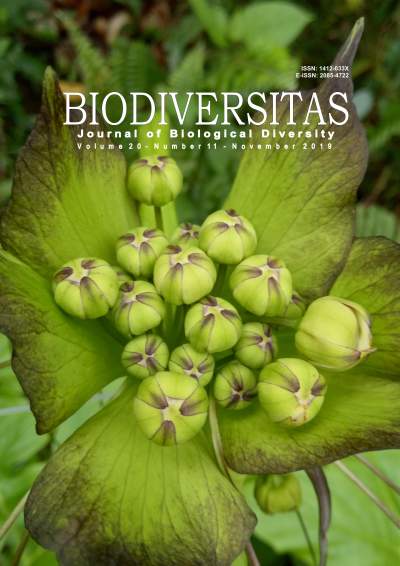The potential of Mesangat Lake, East Kutai, Indonesia as an essential ecological area for habitat conservation of critically endangered Crocodylus siamensis
##plugins.themes.bootstrap3.article.main##
Abstract
Abstract. Sudrajat, Saleh HA. 2019. The potential of Mesangat Lake, East Kutai, Indonesia as an essential ecological area for habitat conservation of critically endangered Crocodylus siamensis. Biodiversitas 20: 3126-3133. The Siamese crocodile, Crocodylus siamensis, is one of the most threatened reptile species in the world with IUCN Red List status of Critically Endangered. This study aims to investigate and assess the biogeophysical conditions of Mesangat Lake area, Indonesia as an essential ecological area for C. siamensis conservation outside biodiversity conservation areas. Data was collected through direct survey using spotlight technique at night, tracking, observation and interviews with local fishermen. The results showed that the biogeophysical conditions of Mesangat Lake habitat in Long Balau, Loah Toh and Abang areas still support C. siamensis population which was marked by the presence of its nests and the occurrence of 17 individuals with sizes between 30 and 50 cm in length. Habitat conditions in the form of lake waters had depths between 30-110 cm, low currents, and covered with aquatic plant species for resting, nesting and basking, as well as contained sufficient diversity of fish and other prey. A nest was also found in the form of mound of plants measuring ± 45 cm high and ± 75 cm wide which contained 20 eggs with an average length of ± 8.45 cm, an average width of ± 4.9 cm. Potential factors that threaten C. siamensis habitat included siltation of water bodies caused by invasive weeds, over-exploitation of fishes and conversion of lake land into plantations and/or agriculture lands. Based on the results of this study, it can be stated that Mesangat Lake has the potential to be designated as an essential ecological area of C. siamensis habitat. Through this strategy, it is hoped that there will be good collaboration between local government and concession rights holders, NGOs and local communities to participate in the conservation of C. siamensis. In the area of the lake, zoning can be classified into areas of nesting, closed areas, playing and sunbathing, limited fishing, recreation.
